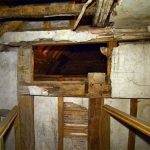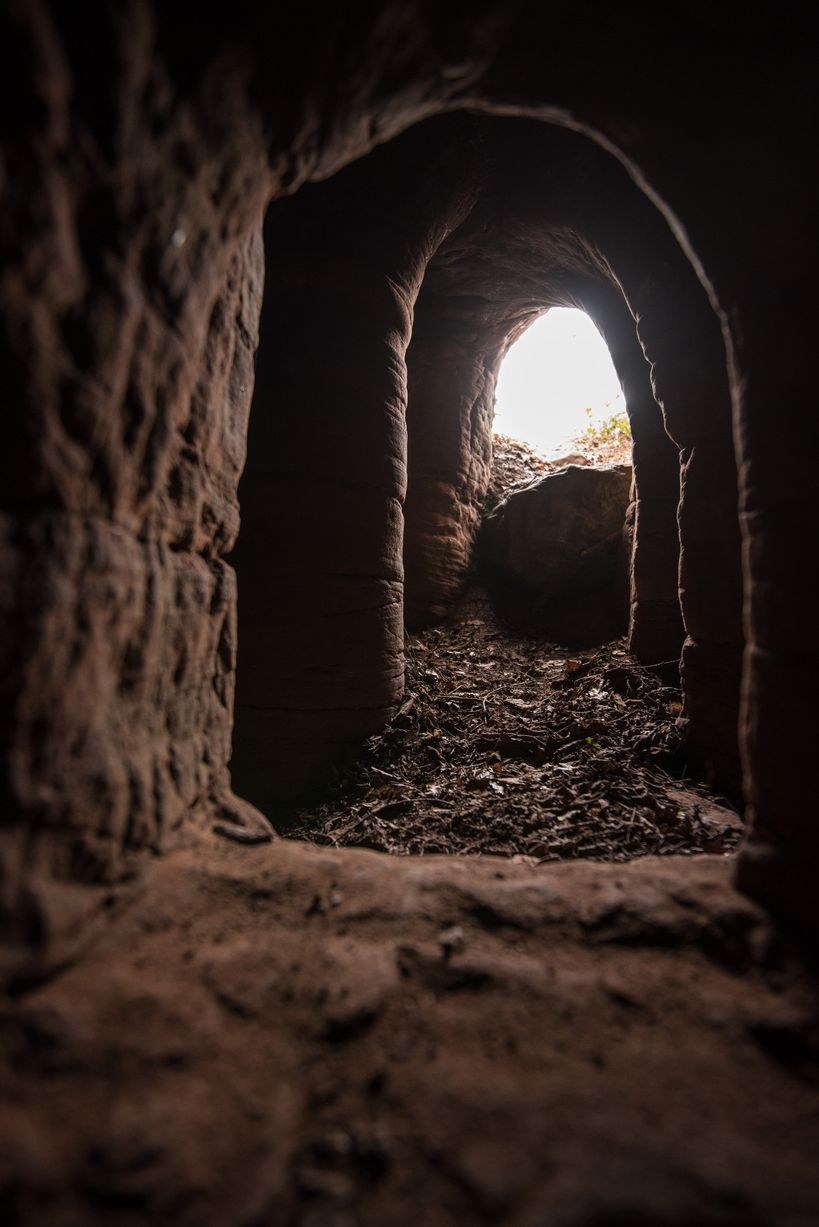
It is a well known fact that an underground tunnel connects 10 Downing Street, the British Prime Minister’s residence in London, with number 12 (we’re not sure why number 11 was left out) but it is surprising just how many residences, both old and new, are harbouring hidden passages. Secret doors and passageways have been used in structures for thousands of years – the Egyptian pyramids are full of them. There is something thrilling about stumbling upon a hidden portal, like Alice plummeting down the rabbit hole; a promise of adventure to come, clandestine tales and mystery. In today’s brief compendium, we explore some of our favourites. Starting with…
Versailles, of course
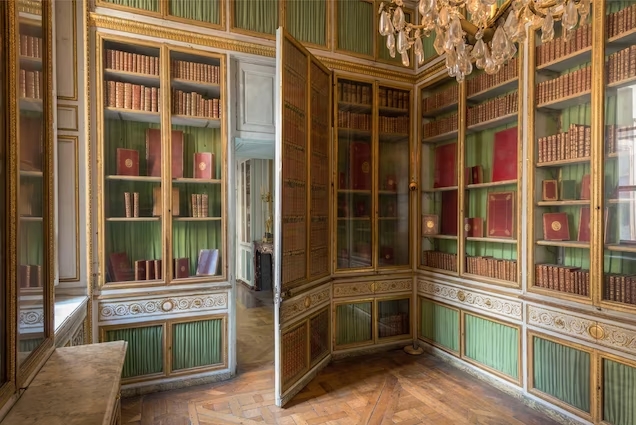
Let’s begin with probably the most famous residence in our compendium, Versailles. In 1682 Louis XIV’s transformation of his father’s hunting pavilion was completed; a monumental space occupying the equivalent of 15 and a half football pitches with no less than 2,300 rooms. It seems, however, that even in a building this vast, royal life had to be acted out in public. The palace was always crowded with visitors, residents and staff numbering up to 10,000 depending on the day and royals were obliged to complete all their duties in front of an audience, including giving birth. They were even expected to sleep in public when guests and court members were present, retreating to their private chambers once they left but arriving back in their public beds before sunrise so they could be witnessed and awoken there. It is little wonder then that concealed beneath rococo friezes, Venetian mirrors and plush carpets, a labyrinth of trapdoors, passages and tunnels was constructed permitting all manner of less public activities. Secreted behind the wall of Queen Marie Antionette’s public bedchamber, where she received countless women for her daily lever, lies her private bedchamber where, who knows what went on…
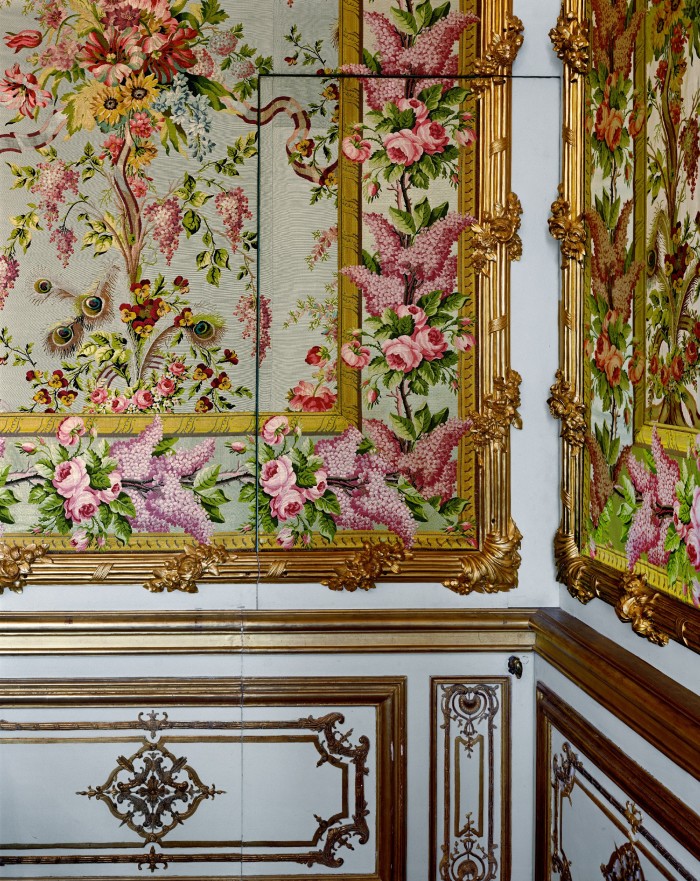
It was through this same door that the Queen is thought to have escaped the angry mob who stormed Versailles during the French Revolution.
The Rotting Underwater Ballroom of a Victorian Bernie Madoff
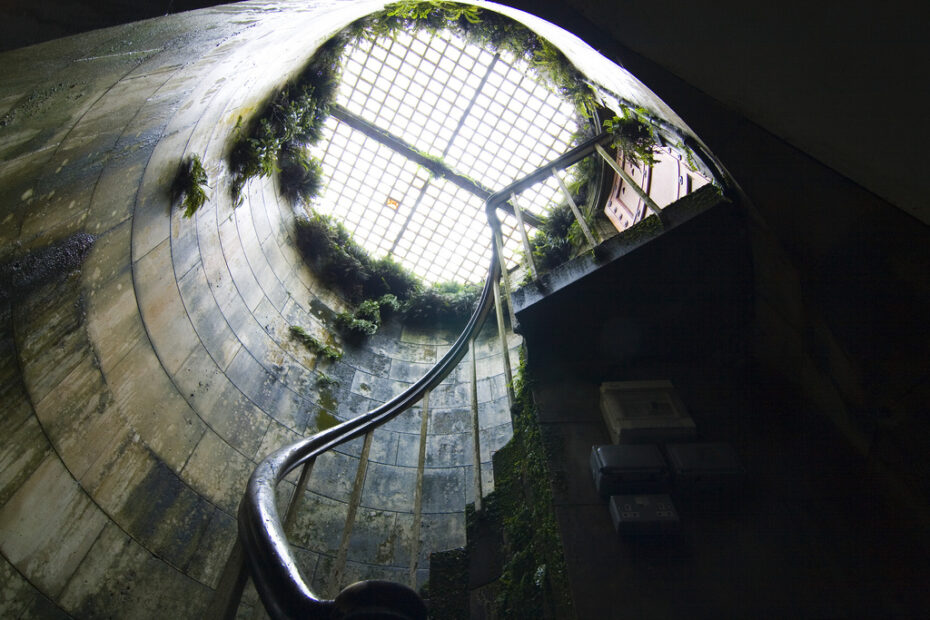
Beneath the lake of a once lavish Victorian estate built by a flamboyant mining tycoon, a secret awaits. At the murky water’s edge, a stone structure being overtaken by greenery hides a locked door…
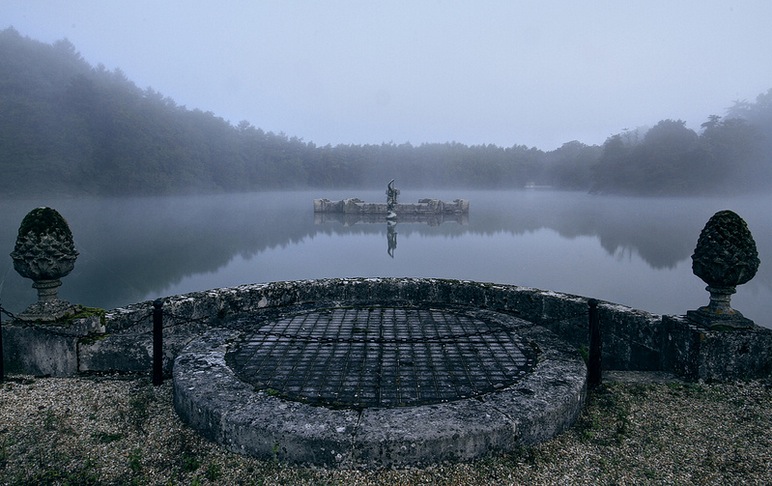
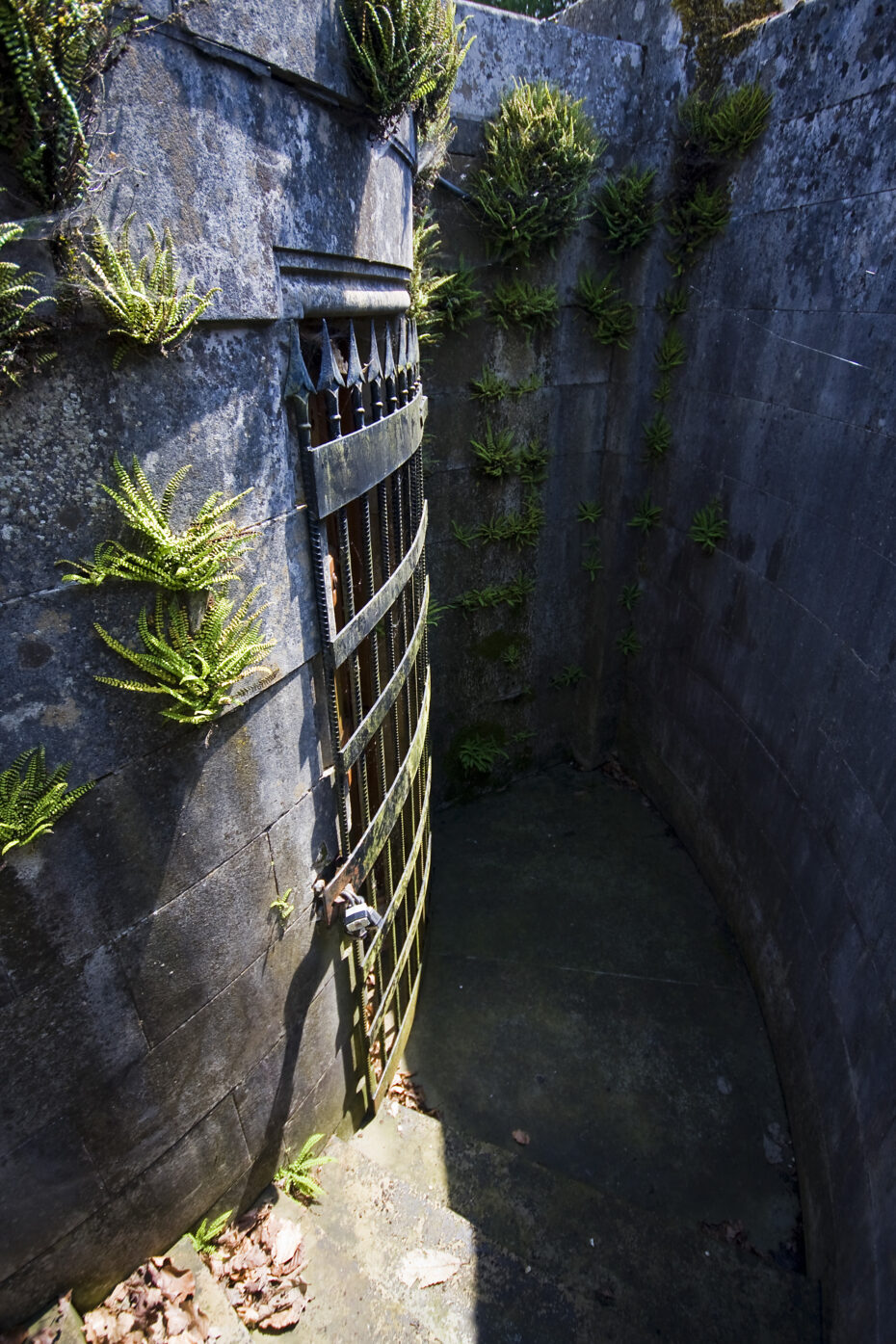
If you happen to have the right key, it will lead you down a spiral staircase and underneath the lake until you’re standing right at the centre below a statue of Neptune which appears to walk on the water’s surface
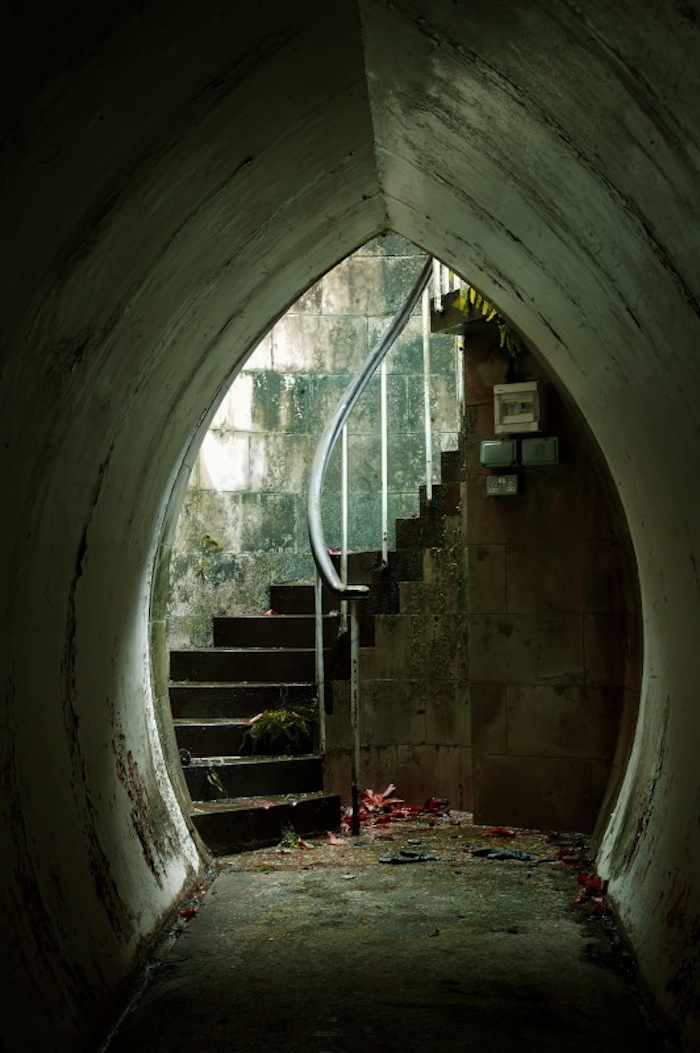
The strange and damp tunnel 40 feet below the surface leads to a long-forgotten architectural marvel, the sodden remains of one man’s elaborate Victorian fantasy come true– before it all came to a very abrupt and scandalous end…
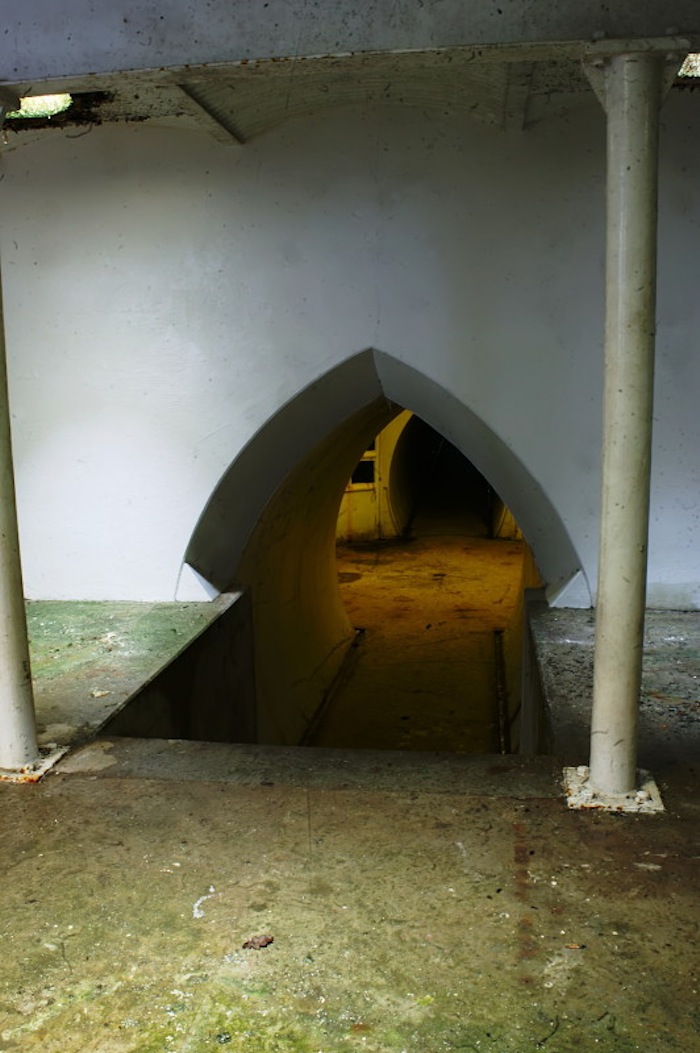
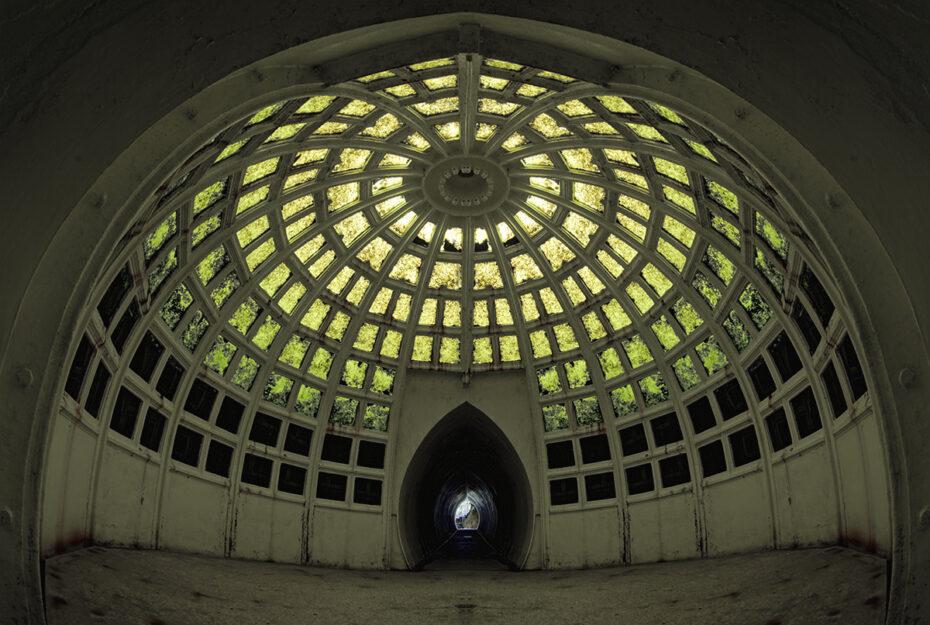
Welcome to the abandoned underwater leisure room built by mining magnate Whitaker Wright who made his fortune in America before returning to England. The circular domed room, about 20 feet in diameter, was one of his last lavish projects installed at his ostentatious Surrey estate, which also boasted a theatre, observatory, velodrome, private hospital and stables to accommodate more than 50 horses. On the apex of the dome, stands the statue of Neptune, through which historians say a pipe led up to the surface for expelling excess cigar smoke. A smoking room, a billiards room, a ballroom– there are varying opinions on what exactly Wright used the room for, but whatever its official purpose, it would no doubt have been very useful for impressing guests. These illustrations unearthed by local historian, Hugh Thurrall-Clarke from a British periodical magazine of the 1920s, show what the lake would look like drained of water, exposing the tunnel leading from one side of the lake to the other.
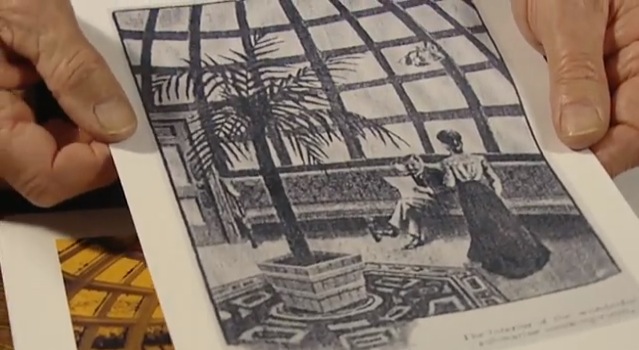
The domed room is depicted as a smoking lounge, with mosaic flooring and a deep-buttoned seating bench that curves with the room. Today, the room is bathed in yellow light during the day from the build-up of algae on the glass and metal dome. In its heydey, Wright brought in trainee divers to clean the outside of the glass. Despite the clues left behind of an extravagant show piece, this secret ‘aquarium’ hasn’t entertained for many decades, and the scent of Whitaker’s exotic brand of cigars hasn’t lingered here since 1908 when he took his own life to avoid his doomed fate.
A Victorian “Bernie Madoff”, Wright was convicted of fraud and faced a seven-year imprisonment after a career of fooling trusting investors to back non-existent mining projects while he poured their money into his estates and follies (like underwater ballrooms). Immediately after he was sentenced, he committed suicide by swallowing cyanide in a court anteroom.
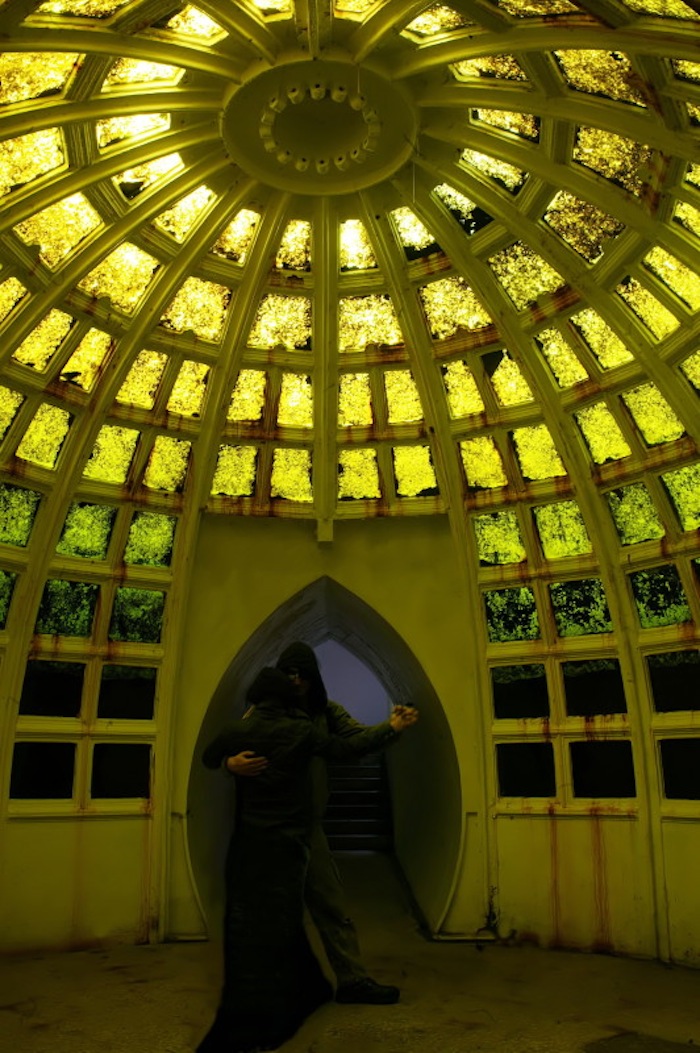
After his death, Wright’s estate was auctioned off and sold to Lord Pirrie, notable for his role in the building of the Titanic. As for the underwater ballroom, it’s unknown whether Pirrie made use of it, but some locals of the area claim that in the 1930s, their ancestors would sneak into the park and down into the dome with candles and a wind up gramophone to hold clandestine dances there at night.
Even damp and deserted, you can almost imagine it as it was once intended; impressively lit, expensively furnished with the echoes of laughter and dancing feet while fish pressed their noses against the glass to see what was going on.
Witley Park is now a private family home, not open to the public. In 1952 a tragic fire destroyed the 32-bedroom mansion built by Wright and the gutted remains were demolished. In later years, a new modern home was built elsewhere on the property. The landscaped park still remains however, along with the lakes, run-down boat houses and the hidden ballroom. Permission is very rarely granted to see it, although determined visitors occasionally tend to find their way in anyway.
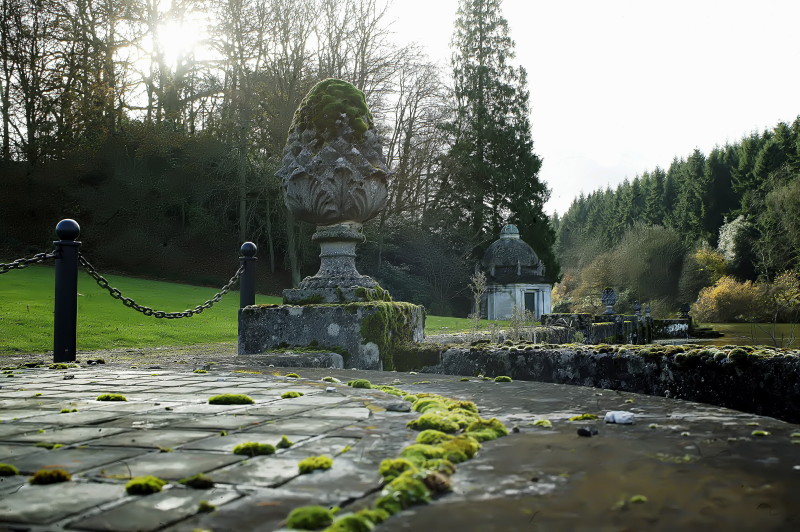
What will be the fate of this strange secret of underground Britain? What could it be used for today? I’m certain there won’t be a shortage of imaginative ideas out there …
The Secret doorway found in British Parliament
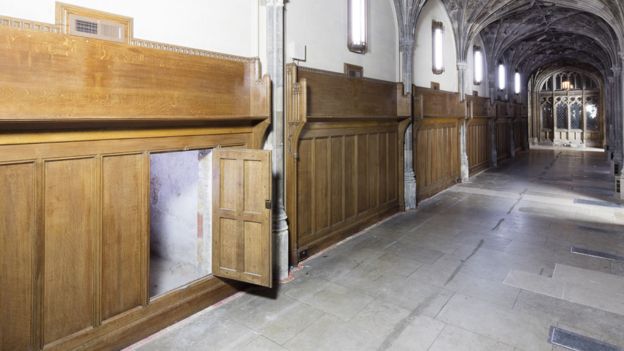
The first thing they found when they opened it up was an old barrister’s wig hanging on the wall.
More on BBC.
The Secret Tunnels (and bunker) beneath the Eiffel Tower
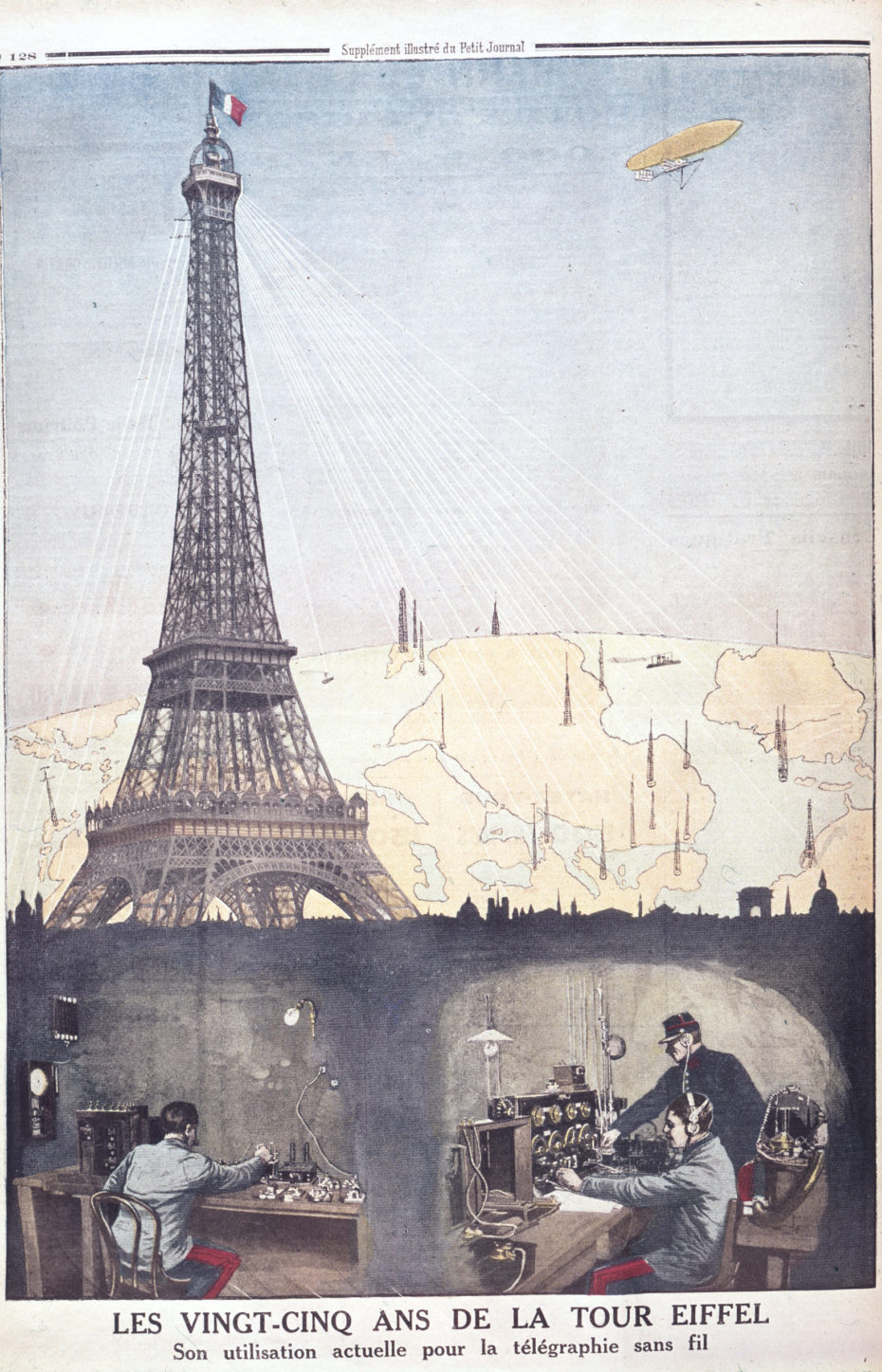
You may or may not be aware that Gustave Eiffel used his iconic Eiffel Tower as a personal start-up lab for scientific innovation (hint: you probably heard it from us). But did you know that there’s also a “secret” military bunker still buried beneath, with an entrance near the south pillar?
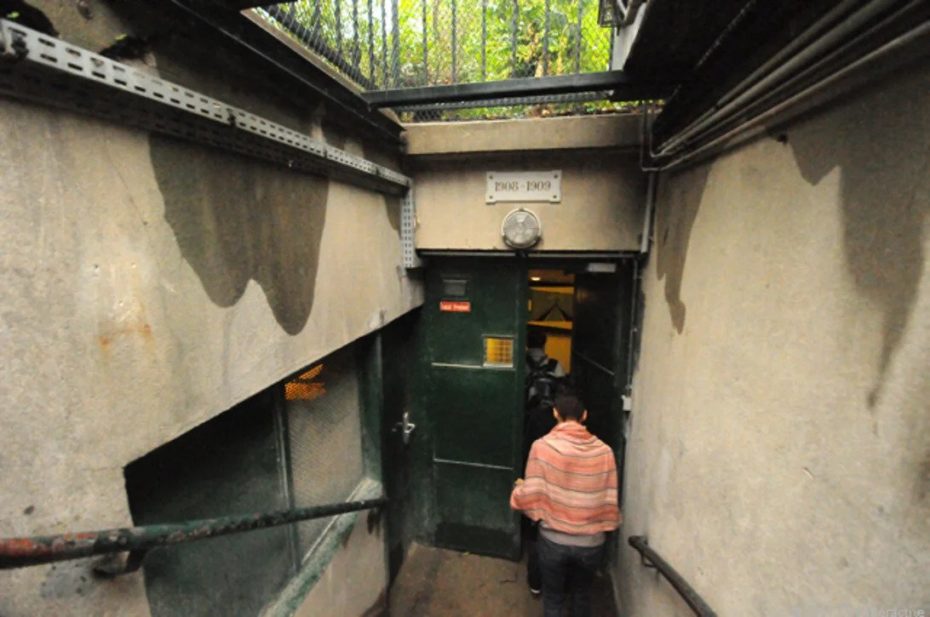
The bunker — which was not originally created to withstand army bombardments — was constructed in 1909 for the military telecommunications that took place from the Eiffel Tower. During World War I, its bunker took on an even more important role as a potential escape route with a complex underground network and secret tunnels. The Iron Lady’s communication infrastructure proved especially useful when French forces jammed German communications, a significant factor in winning the First Battle of the Marne. The French military were also able to decrypt enemy messages; notably, an intercepted communiqué between Germany and Spain led to the arrest of exotic dancer and spy Mata Hari. The tunnel remained a military secret for some 70 years and some mysteries of the bunker remain, including whether there is a tunnel stretching across the famed public gardens of the Champ de Mars to the French École militaire training facillities. Off-the-beaten path visits of the Eiffel Tower’s underground space have been possible in recent years but have recently been discontinued. Take a staircase down 4 or 5 meters and you find yourself in a small, makeshift underground museum at the entrance of the old bunker, highlighting some of the iconic landmark’s lesser known history. But the truth is, the nucleus of the bunker hasn’t been seen by the public for some time and what remains would only disappoint visitors hoping to see a preserved wartime shelter. It’s perhaps a missed opportunity for one of the world’s most visited landmarks, which now uses the demilitarized bunker for a much less exciting purpose – storage – primarily for the food venues inside of the Eiffel Tower. Decidedly more animated for intrepid visitors is the underground space that houses the original machine room which still controls the Tower’s six hydraulic elevators designed by Gustave Eiffel in 1889.
Disneyland
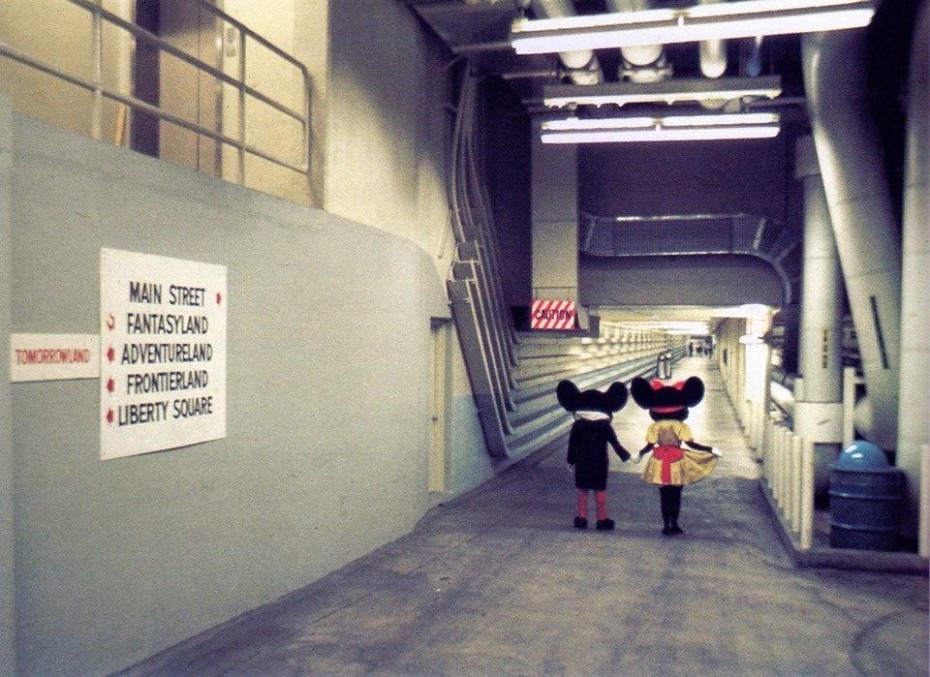
So here’s a fun fact if you didn’t already know it. In 1971, when Walt Disney created Disney World in Florida, he also built an incredibly complex underground tunnel system called the “Utilidors”, for the cast members and maintenance to travel underfoot, unbeknownst to guests.
The idea was that the tunnel network prevented anything out of character from ruining the magic of Disney World for visitors. As the story goes, one day Walt was taking a walk through Disneyland in California when he was bothered by the sight of a cowboy walking through California Disneyland’s Tomorrowland en route to his post in Frontierland. He felt that such a sight was jarring, and detracted from the guest experience. And so, the Utilidor tunnel was born.
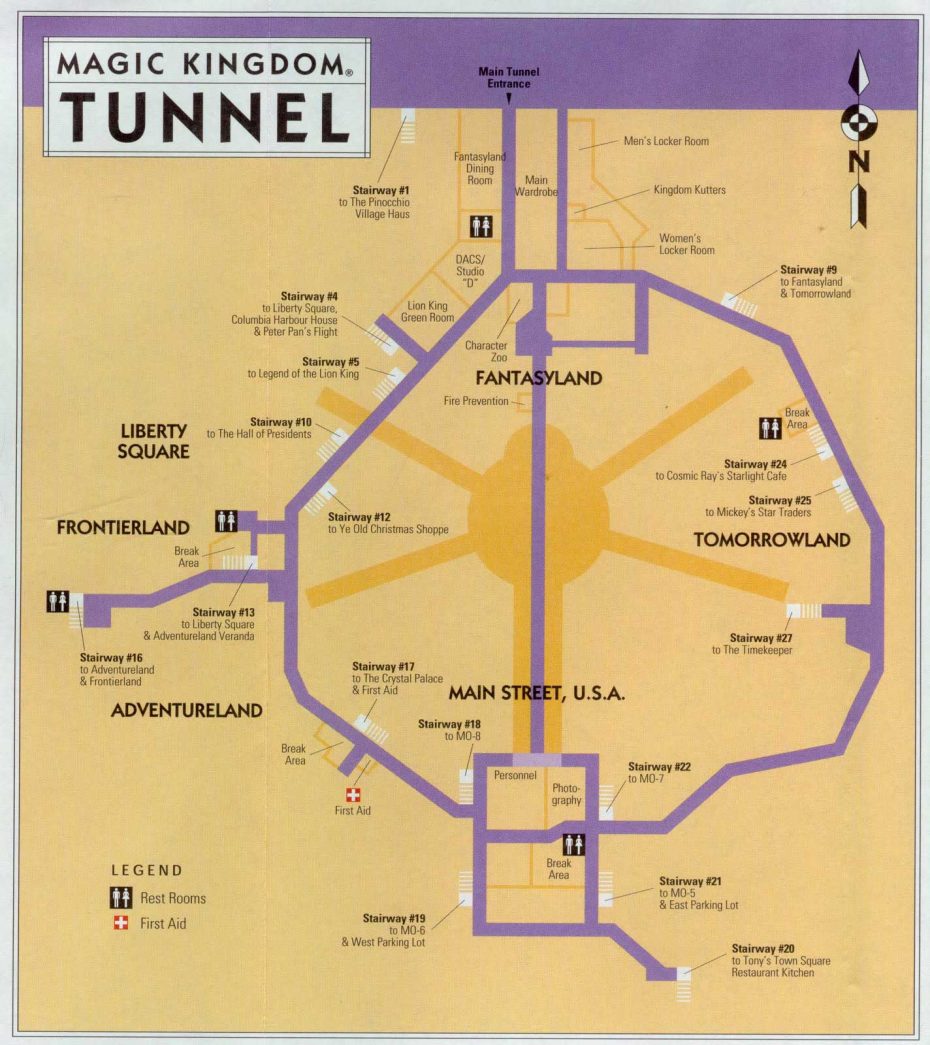
These secret underworld covers up to 9 acres with some tunnels so long that golf carts are used by employees. The enormous urban basement also houses make up rooms, dressing rooms, cafeterias (!), design, decorating and rehearsal facilities. There is even a check cashing service and an employee hair salon called “Kingdom Kutters”. Of course we could only ever access them if we applied for a job at DisneyWorld, but check out this vintage footage giving us a glimpse into the tunnels…
It’s also handy for Mickey Mouse to take his cigarette break in peace…
Priest Holes
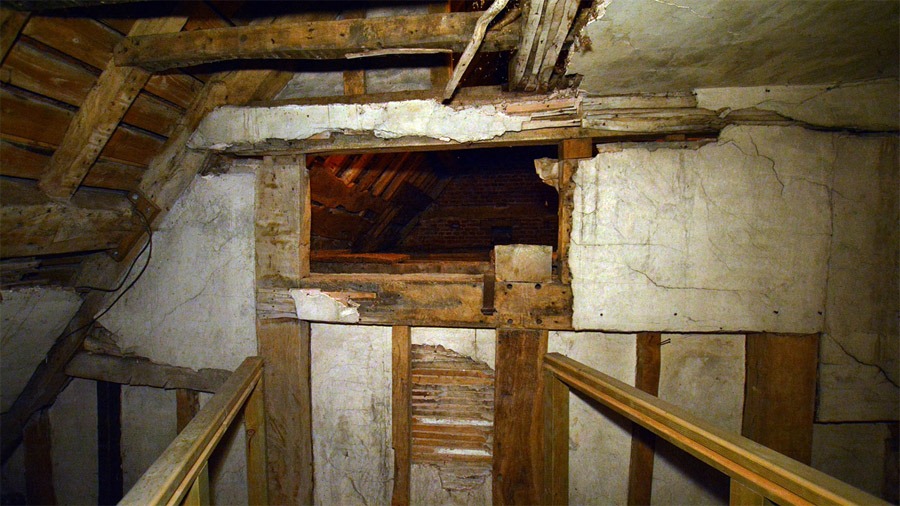
Once upon a time in ye olde England, it was illegal to be Catholic. In case you need a quick refresher: King Henry VIII needed a male heir to the. He blamed Catherine of Aragon (his brother’s widow and the first of his six wives) for not bearing him a son. On these grounds, he asked the Pope for an annulment, which was refused, so Henry founded his own church (the Church of England). And because he was King, aka God’s own emissary on earth, the entire country was required to convert to his new religion. Over the next few generations, the United Kingdom yo-yoed between Catholicism and the Protestant faith as new inheritors of the crown prosecuted those who refused to convert their preferred religion. Queen Mary, aka “Bloody Mary” terrorised the nation, burning Protestants at the stake for not converting back to Catholicism. And during the Protestant Reformation of the 16th century, Queen Elizabeth I determined that it was High Treason for a Catholic priest to even enter England, so she established an order of priest-hunters, also known as “pursuivants.” In response, the Jesuit order of priests was founded in 1540 to support Catholic families and dispersed to wealthy families under the guise of being uncles or teachers. They would meet at safe houses. And these safe houses were characterised by a peculiar secret feature: Priest Holes.
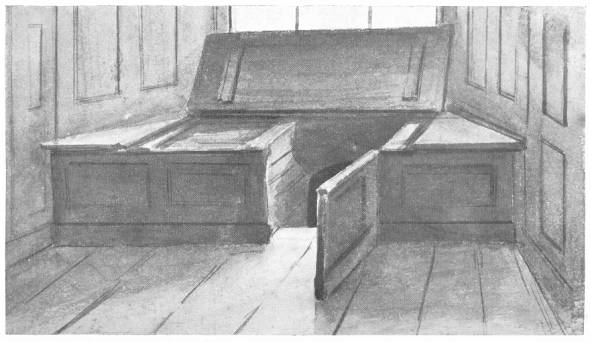
Priest Holes are pretty much what they sound like: tiny, tucked-away medieval panic rooms where Catholic families could hide their priests. The hiding holes were always very small. They had to be – the pursuivants were on missions to smoke out heretics. They were no taller than four feet, wedged in any space the house could discreetly accommodate, and they were installed specifically for this purpose.
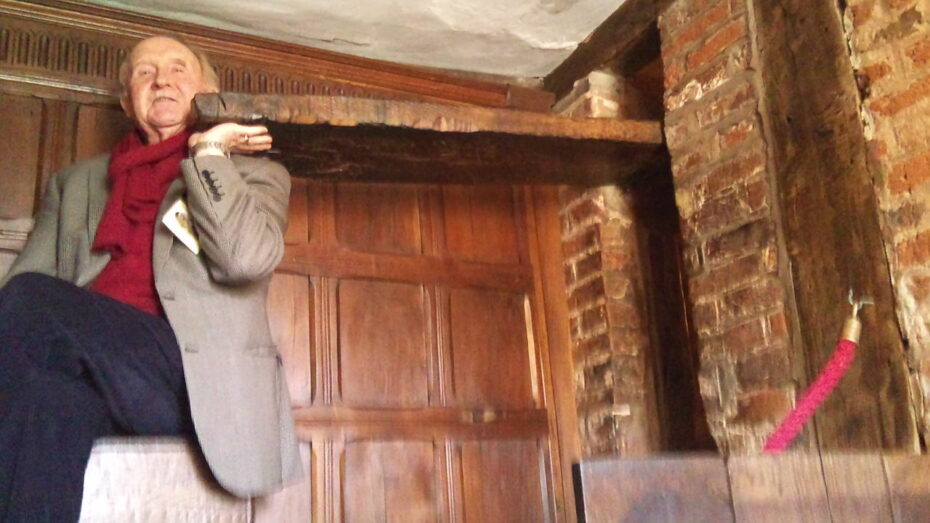
When priest hunters became wise to these hidden spaces, they would lie in wait until the families thought they had gone, and then seize the priest when he emerged. Sometimes the pursuivants would even pace out the walls to make sure they measured accurately. They tapped on walls to check for hollow sounds. They tore up floorboards. They checked blueprints.
Some homes, like the Scotney Castle, had multiple Priest Holes (you can find a list of National Trust estates open to the public where priest holes were found here). At another manor house in Warwickshire, numerous hideaways were found: one in the roof space above a bedroom closet, one on the other side of the Great Parlour’s fire place one and one even hidden through the toilet shaft. Of course, no matter how sound the Priest Hole itself, if the priests were forced into hiding for days, they could suffocate or starve to death.
Mysterious Knights Templar Rabbit Holes
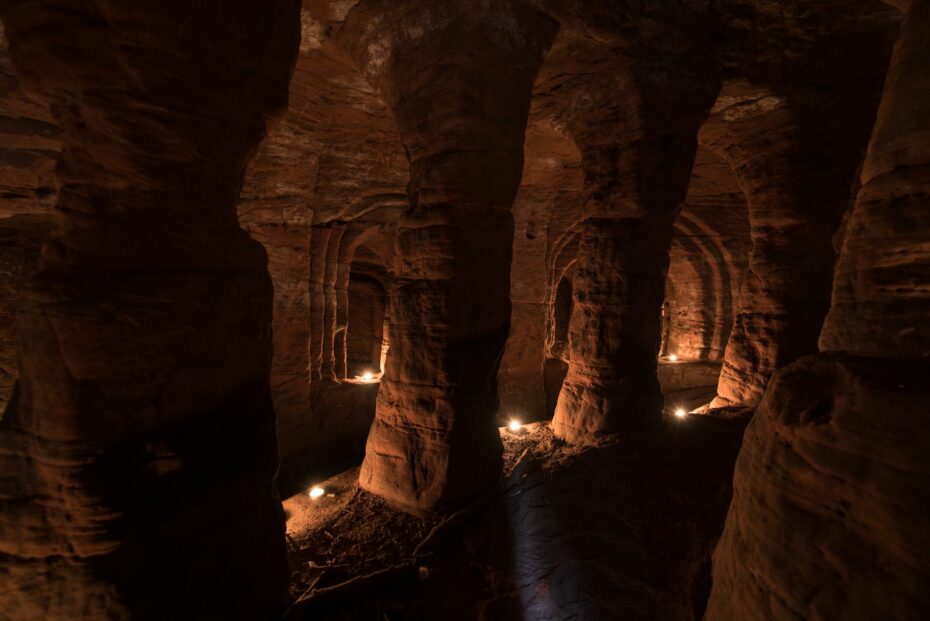
Have you heard about the Caynton Caves? In Shropshire, England, on the estate of an historic English estate, a series of rabbit holes leading into what’s being speculated as a possible 7oo-year-old secret Knights Templar cave network, has the obscure-hunting interweb going a little gaga. Of course, there’s one obvious explanation– Rabbit Templars! But with the obvious aside, we did some digging of my own to entertain a few of the facts, which can often be hard to come by when a story is going viral. So here’s what we know…
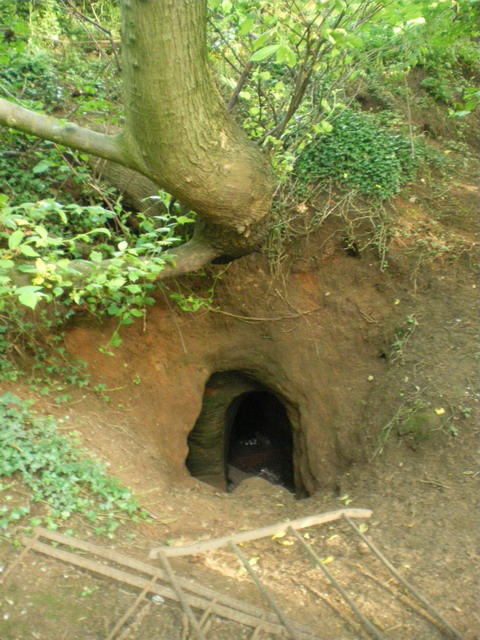
The grotto is cut from a disused red sandstone quarry. The entrance looks like a series of rudimentary rabbit holes but the interior caverns comprise of a series of man-made neo-Norman/ Romanesque passages and chambers, some small enough that they can only be entered on hands and knees. There are carved archways, pillars and niches made for candles. While it can’t be confirmed that the caverns were associated with the Knights Templar, according to the site owners, they have been notably overrun by magic cults since at least the 1980s, often used for informal secret ceremonies and sacrificial rituals (there is a “sacrificial stone”).
There’s also a video walk-through:
The caves are located on the privately-owned property of Caynton Hall, about 250 meters west of the main house, beneath a farmer’s field. Caynton Hall was built as a gentleman’s house in the late 18th or early 19th century by William Yonge (1775-1803), believed to have made his fortune in the United States.
According to historical records, the estate may have been built on the site of an earlier farmhouse called Dennetts Hays. Caynton Hall was later altered in the 1850s by a Colonel Legge, and again in the 1960s before the estate was divided into three parts in 1977.
This rather official-looking heritage site estimates the grotto was created between 1800 to 1850. This less adventurous of theories suggests the caverns are the result of quarrying during the 19th century and likely later turned into a grotto by the wealthy Legge family as a folly.
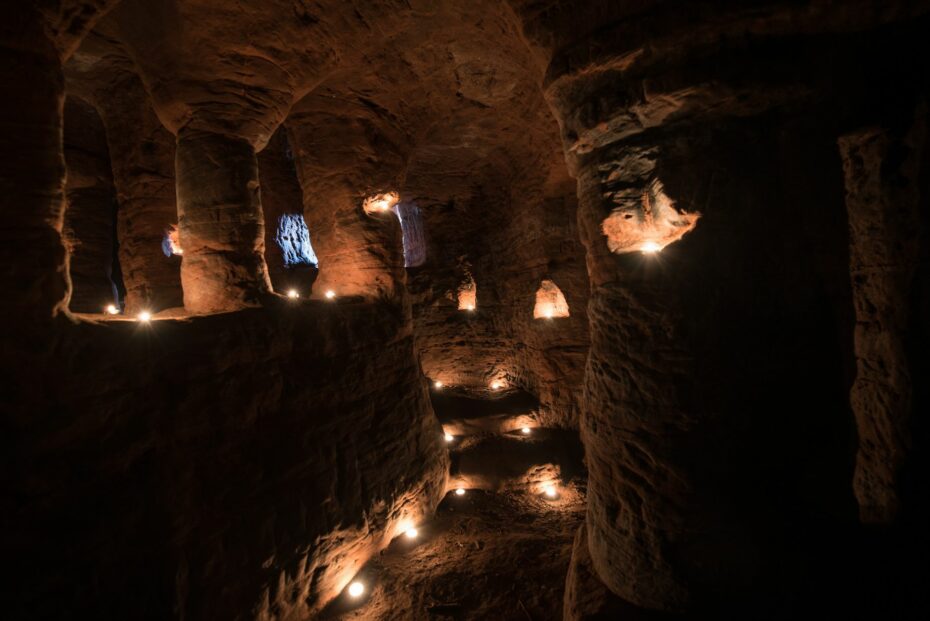
With the grotto’s strong resemblance to a temple however, it’s been strongly speculated that the caverns are older, and could have been carved out by followers of the Knights Templars, a medieval religious order which fought in the Crusades, as a place where they could worship without being persecuted.
Another more imaginative local rumour is that a landowner hid slaves down there when slavery became illegal. The hearsay claims he would have hid as many as 60 slaves down there. The cave’s original purpose and date of construction continues to be disputed. Wrought iron gates have been placed over the small rabbit hole entrances, but unwelcome intruders have removed them several times. To be clear, this cave network is located on private property and is not open to the public.
Dan Brown’s House
Dan Brown is known for incorporating secret passageways into his novels, such as the Vatican archives in “Angels and Demons” and the Masonic temple in “The Lost Symbol.” Is it any wonder his own private home is built with secret doors and hidden passageways?
The Attic that inspired Jane Eyre
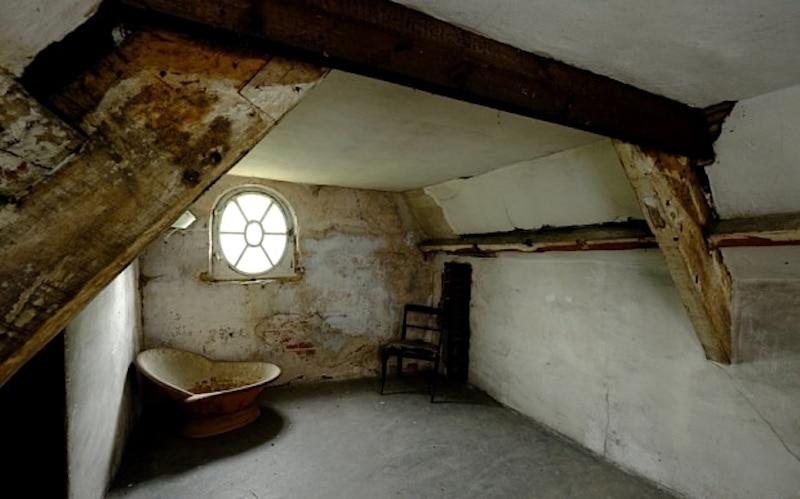
Charlotte Brontë’s Jane Eyre is well known for the shocking discovery of Mr Rochester’s scandalous hidden wife, a deranged woman locked away in an attic. But astonishingly, this may not have all been fiction. Norton Conyers, the stately manor that Thornfield Hall is based on, was filled with rumours of a mad woman who lived in the attic — which is where Brontë found her inspiration.

It was only recently that a cramped secret staircase winding up to a lonely garret was rediscovered in a 16th North Yorkshire manor house, which is credited with launching the literary genre of the “madwoman in the attic”. The staircase, found when floorboards were lifted in an attic, filled in a missing piece of Brontë’s careful description of “Thornfield Hall”, where Mr Rochester lived with the governess Jane Eyre and – hidden away on the top floor – his “mad” first wife.
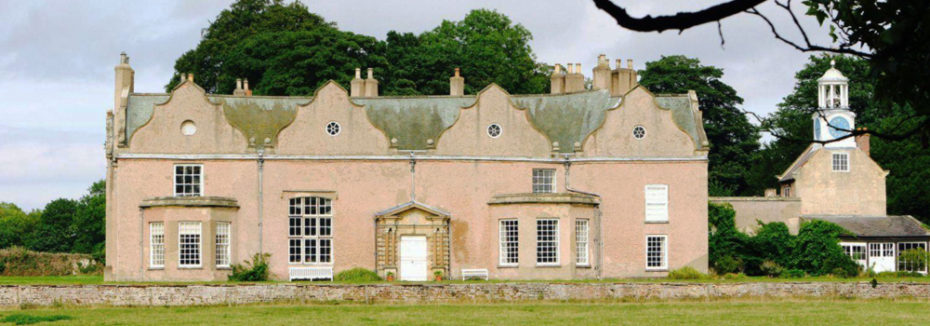
Charlotte visited Norton Conyers in 1839 and knew the story of the manor’s “madwoman” – probably epileptic or pregnant with an illegitimate child – who had been kept locked in an attic 60 years earlier. Thirteen rotting steps lead into a gable end where the 18th century original of Mrs Rochester – the tragic enigma at the heart of Charlotte Brontë’s Jane Eyre – was allegedly confined. Norton Conyers has finally been unveiled to the public after its 30 year restoration, and the attic room is part of the visit. “It is such a sad room,” said Lady Graham, owner of the manor. “It has such a tragic feel about it. It is in a cul-de-sac in the attic, very awkward to reach.”
Visitors info here.
Austrian Libraries
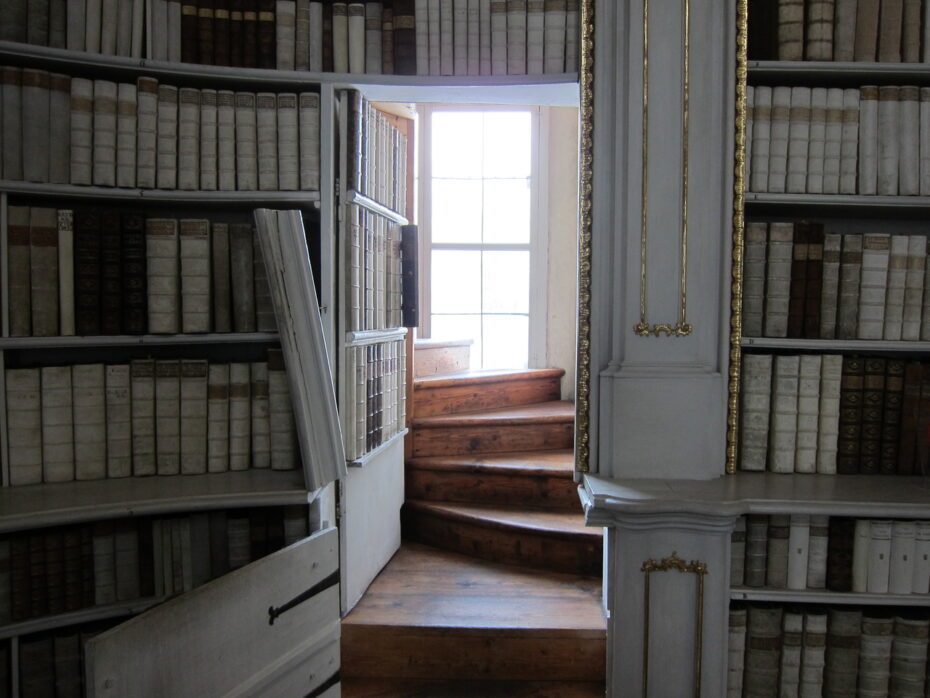
Stift Admont Library is located in Admont, Austria and is the largest monastic library in the world. The library was built in the 18th century in the Baroque style and features impressive architecture, artwork, and a vast collection of books, manuscripts, and scientific instruments.
One of the most intriguing features of the library are the secret doors hidden throughout the space. These doors were designed to look like bookshelves or walls, but when pushed open reveal hidden chambers and passageways. The secret doors were built as a security measure to protect the valuable books and manuscripts from theft or damage.
One of the most impressive secret doors is located behind a bookshelf in the Astronomy Room. The door opens to reveal a staircase leading to a hidden chamber, which was used by the monks as a study and meditation room. Another secret door is located behind a wall in the Philosophy Room and leads to a secret passage that was used by the monks to move between rooms without being seen.
Today, visitors to Stift Admont Library can take a guided tour and see the impressive collection of books and manuscripts, as well as the hidden chambers and secret doors that add to the library’s mystique and intrigue.
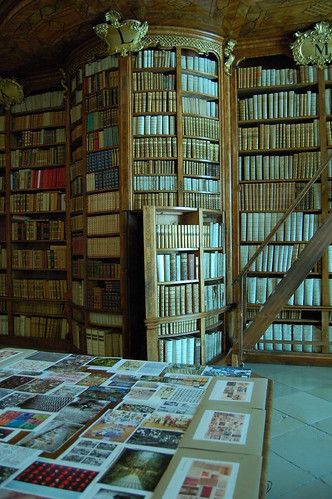
St. Florian Library is a stunning Baroque library located in the town of Sankt Florian in Upper Austria. It was constructed in the 18th century and houses over 150,000 volumes, including rare and valuable manuscripts, maps and of course, secret doors. These doors were also used by the monks to move around the library undetected and to protect the valuable books from theft and damage.
The original rabbit hole at Consort House
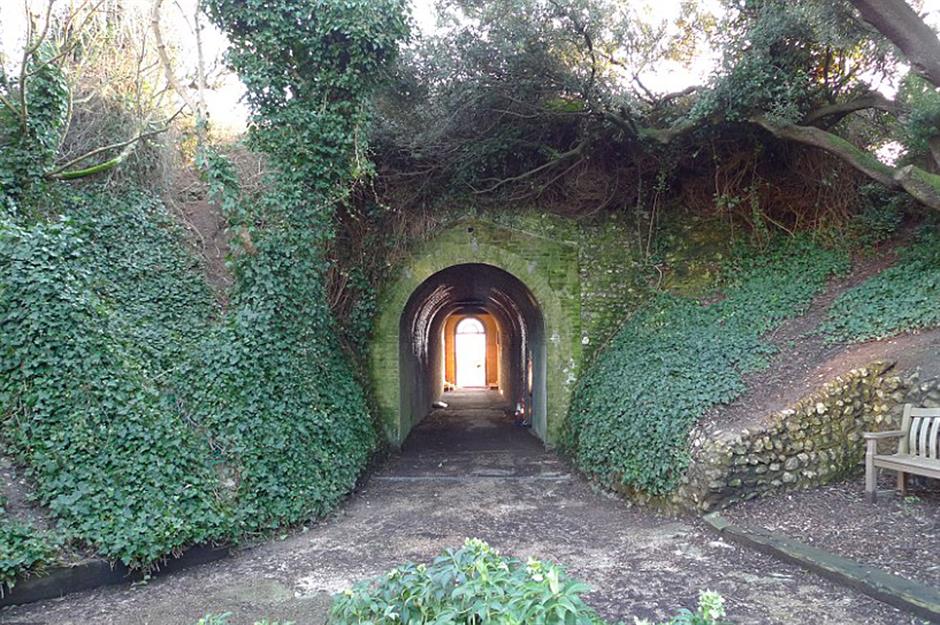
It has been suggested that this very passage was the inspiration for Lewis Carroll’s rabbit hole to Wonderland. Consort House is a Nineteenth Century Grade I listed townhouse in the seaside town of Brighton, UK , which the author did visit more than once prior to writing his best-seller. This beautiful property hides a most charming and unusual garden feature; a secret tunnel linking the front garden directly onto Brighton sea front.
The Winchester Mystery House

Ghosts and secret passages? Look no further than the Winchester Mystery House, a mansion located in San Jose, California, which was built by Sarah Winchester, the widow of firearm magnate William Winchester. Construction of the house began in 1884 and continued for almost 38 years until Sarah’s death in 1922. The house is known for its strange and labyrinthine architecture, with staircases that lead to nowhere, doors that open onto blank walls, and secret passages throughout the structure.
The house was built in this manner due to Sarah Winchester’s belief that the spirits of those killed by Winchester rifles were haunting her and that she needed to continuously build to appease them. The mansion features over 160 rooms, 47 fireplaces, and numerous oddities such as a room designed to confuse ghosts, a door that opens onto a steep drop to the ground, and a staircase with 13 steps leading nowhere.
The house also features many secret doors and passages, which were likely used by Sarah Winchester and her servants to move around the mansion unseen. These passages lead to hidden rooms, staircases, and corridors throughout the house, some of which were discovered years after the mansion was built. The secret doors were designed to blend into the walls, bookshelves, and other architectural features, making them difficult to spot.
Today, visitors can tour the Winchester Mystery House and explore the many oddities and secret doors throughout the mansion, providing an intriguing glimpse into the mind of Sarah Winchester and her unique architectural vision.
Liverpool has a Buried Underworld and No One Knows Why
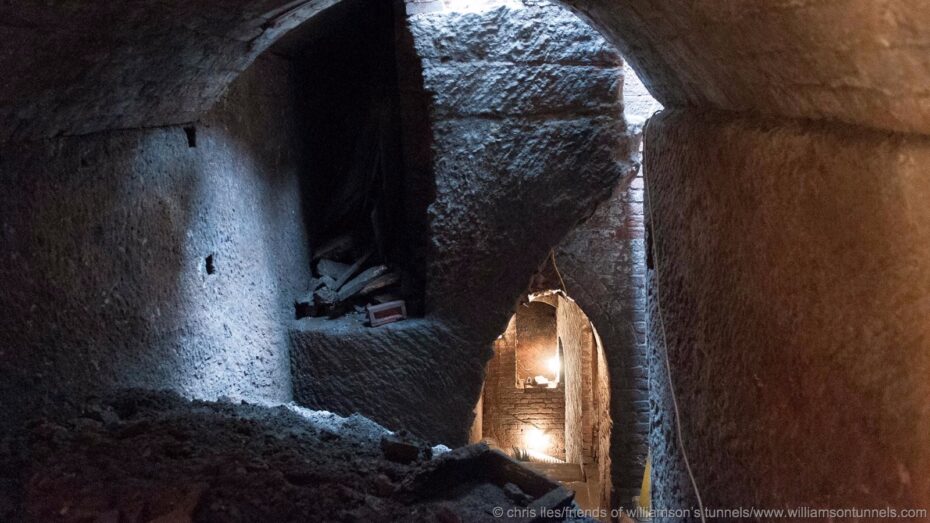
For fifteen years, retired Liverpudlian locals and curious have-a-go volunteers have been digging up a vast network of 200 hundred-year old tunnels and cellar systems beneath their streets, not knowing how far they go, where they lead to and why they are even there. The only clue history has given, is that they were built by a successful and philanthropic tobacco merchant by the name of Joseph Williamson, born in 1769. An entrance to the system was even found in the basement of his former house, but there are no known records or paper from his lifetime that give any explanation as to what this secretive underground network was for.
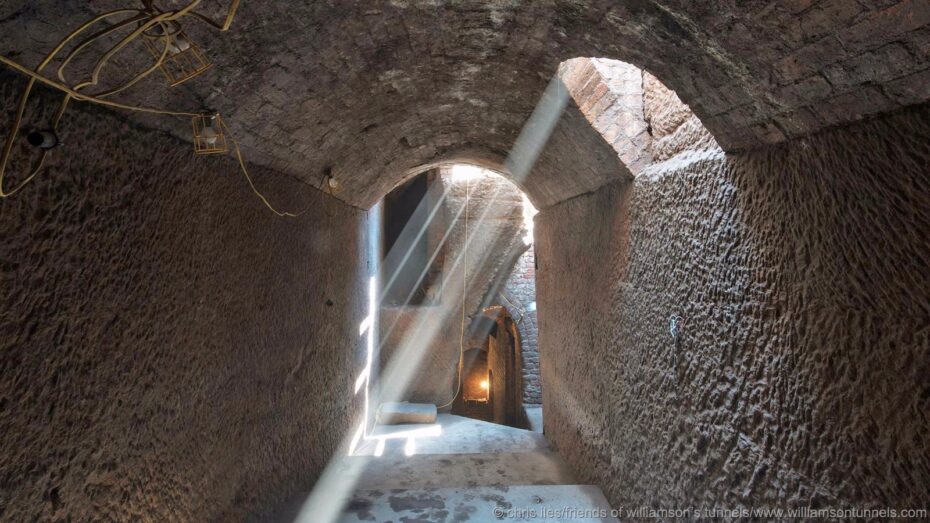
This is particularly strange given the complexity of the design and vastness of the tunnels, which include multiple levels with stone steps leading to caverns as deep as 20 feet. Years before the great railway tunnels and bridges of 19th century England were built, the system features an advanced design ahead of its time, with solid arches that have stood the test of time 200 years on. Such level of construction would have required extensive and skilled manpower on Williamson’s part; hiring a substantial number of workers to build them; and yet, mysteriously, there are no records. The fact that Williamson produced so little documentation about the purpose of his self-financed tunnels reveals that he was very secretive about it. It has even created speculation that Williamson was part of an extremist religious sect, building tunnels where his fellow believers could escape Armageddon and emerge later to build a new city. Less extreme theories suggest he was just a retired local philanthropist responding to the poverty surrounding his neighbourhood by hiring unemployed men to mine some old quarries. After his death, at some point Williamson’s tunnels were filled in after locals complained of the smell coming from the abandoned caverns which had become nothing more than an dumping ground for Liverpool’s trash. Over time, they were forgotten, buried in the past, an urban legend that some Liverpudlians knew about, but no one really cared to explore.
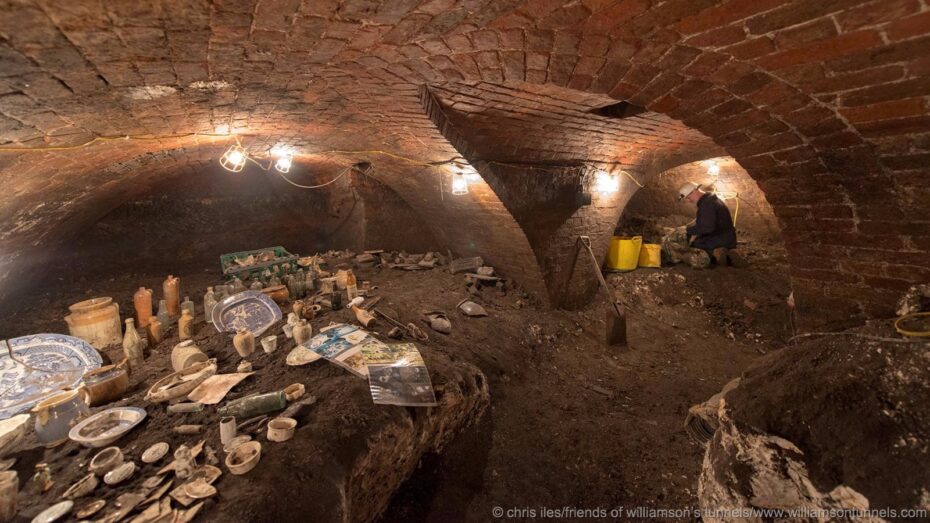
All that changed in 2001 when curiosity got the best of a band of investigators. The group “broke into” a suspected site in Williamson’s former neighbourhood and discovered their first cellar in one of the upper levels of the tunnel system. Ever since, in their free time, the group that calls themselves “Friends of the Williamson’s Tunnels” have been filling more than 120 skips a week with dirt and waste material, as they burrow further and deeper into Liverpool’s subterranean secret. Along the way, they’ve collected enough historic artefacts to fill a small museum, including 19th century smoking pipes, schoolchildren’s ink pots, animal bones and bottles that held “everything from beer to poison”.
Doge’s Palace Secret Torture Chamber
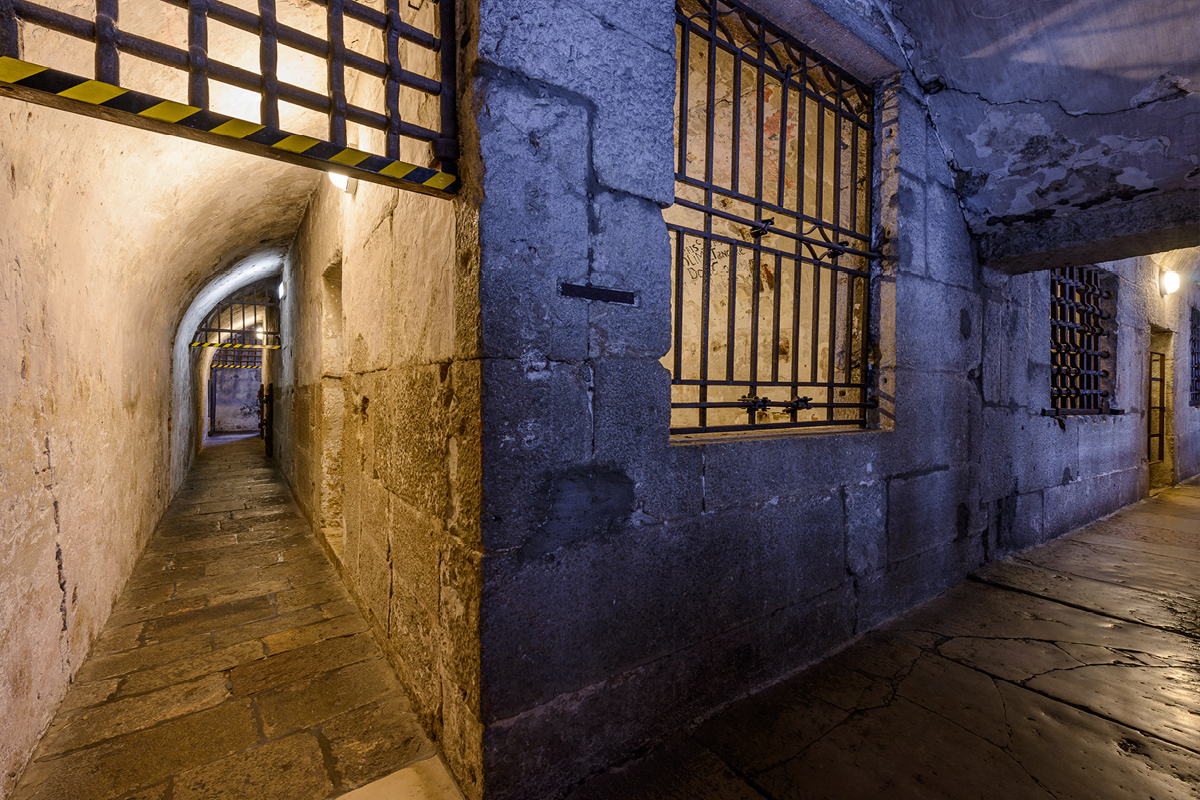
Arguably, Venice’s most famous building is the Doge’s Palace (Palazzo Ducale), a medieval keeper of centuries’ worth of secrets. The Doge was the supreme authority of the Republic of Venice, his palace serving as a home, court, parliament and prison. In the 18th Century, Venice (a requisite of The Grand Tour for every European gentleman) was known as the ‘sin city of Europe’, housing whorehouses and bespoke casinos complete with secret exits at the back and peep holes giving fair warning as to who was at the door. It is no wonder then, that Casanova, the zenith of womanisers, found himself in deep water there. Casanova, by all accounts (including his own) possessed an irresistible charm:
“I was born for the sex opposite to mine… I have always loved it and done all that I could to make myself loved by it.”
In 1755 however, he hit upon an unfortunate choice of conquest – the Chief Inquisitor’s girlfriend. In the city that was home to the secret police, with spies on every corner, nothing went unnoticed. Casanova found himself blindfolded, arrested and marched, via a series of secret passages, straight to the Torture Chamber of the Three Inquisitors, a room of horrors hidden right in the centre of the Doge’s Palace.
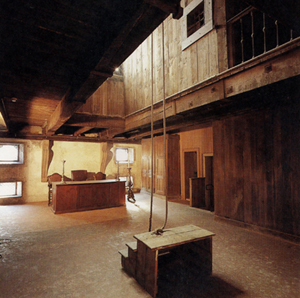
A network of rooms, especially created for the secret police, interrogators and their secret archives, was built directly over the great hall where parliament met, unaware of the prisoners being tortured and held in squalid, pitch black cells above. These cells, piombi in Italian, were squeezed under the lead roof, in the heat and dark, with sitting room only. After suffering at the hands of the inquisitors, Casanova’s thoughts turned to escape:
“My only pleasure, therefore, was to graze on chimerical plans to recover the freedom without which I no longer wanted to live. All I did was think about escape because I was convinced that I could only do it by thinking about it.”
Indeed, after fifteen months of internment, Casanova and one other prisoner managed to escape by digging a hole through the roof, onto which they ran before sneaking back into the building through an open window, casually descending the main staircase and brazenly exiting through the front door. They were the only two prisoners ever to escape the piombi.
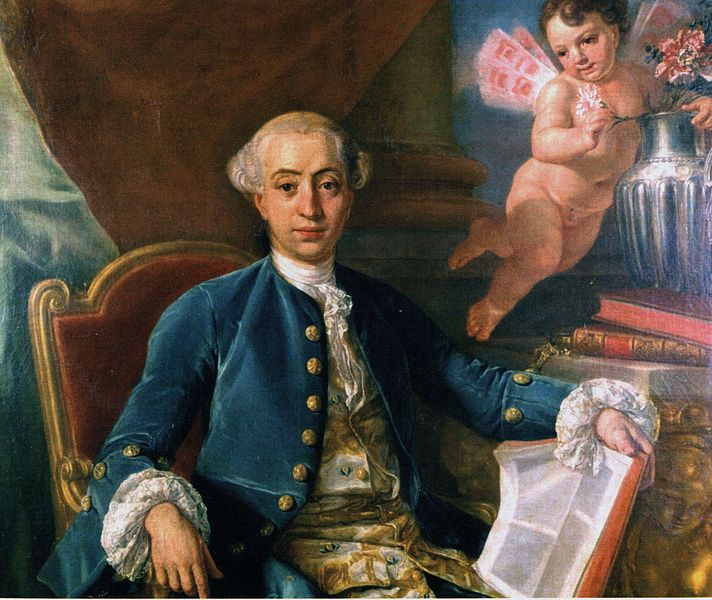
The Fake Brooklyn Townhouse
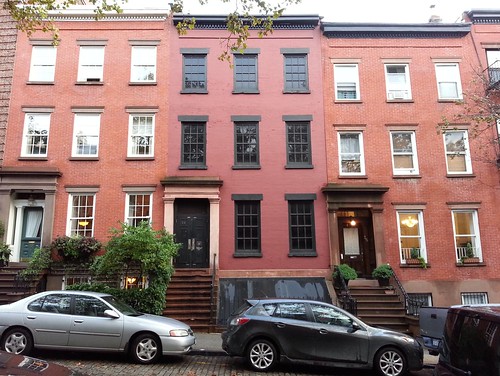
Every city has its secrets, it’s just a matter of finding them. On a street in Brooklyn that takes you towards the river, where the cobblestones begin paving the road, there is a townhouse that deserves a second look. Despite its impeccable brickwork, number 58 Joralemon Street is not like the other houses. Behind its blacked out windows, no one is at home; no one has been at home for more than 100 years. In fact, number 58 is not a home at all, but a secret subway exit and ventilation point disguised as a Greek Revival brownstone.
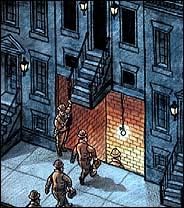
The house stands directly nine stories above the New York City subway tracks for lines 4 and 5, which carries passengers from the nearby station Borough Hall in Brooklyn under the East River over to Manhattan Island. If you approach the front door and peak through the crack, you’ll eyeball a bleakly lit windowless room with concrete flooring and a metal bunker-style door that could easily lead to a bat cave. Every so often, neighbours have reported¹ seeing men dressed in special work suits in the middle of the night hanging around the stoop at number 58.
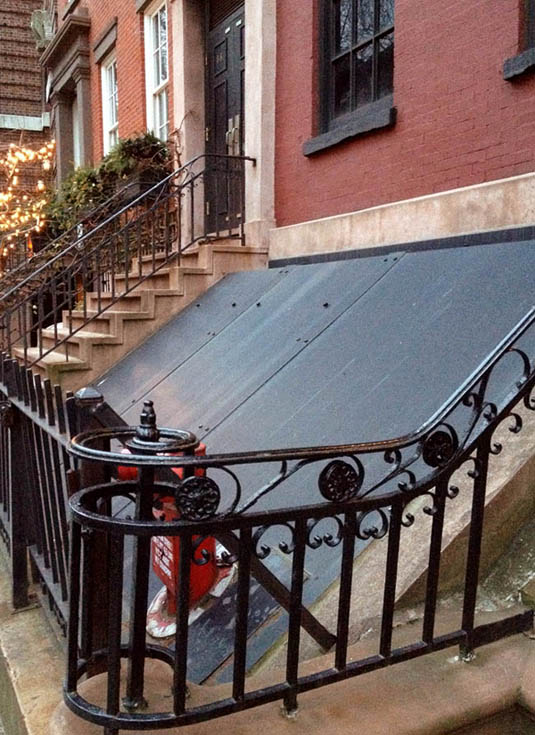
The property was once a private residence dating back to 1847, according to the Willowtown Association, but in 1908, as the first underwater subway tunnel connecting Manhattan and Brooklyn was being constructed, the Metropolitan Transportation Authority of New York acquired the house. The windows were fitted with unsightly industrial steel shutters as the site was converted into a subway ventilator as part of a vast network for the tunnels below. For decades, vented air simply poured out from the windows according to neighbours¹, who knew it only as the “Shaft House”. But in the 1990s, the MTA decided to be a little more neighbourly. When new residents moved in next door, the authority cleaned up the unused backyard at number 58 and offered it to their new neighbours as an extension to double the size of their garden at the reasonable price of $200 a month. Attractive winding vines also now cover the smoothed-over bricked-up windows at the back of the house. In 1999, urged by the local neighborhood and the Landmarks Preservation Commission, the MTA fully restored the historic facade. The industrial steel shutter vents, from where smoke once billowed into the streets, were permanently shut and replaced with sleek opaque window panes. The vents found their new home high up on the building’s roof. Today, the value of number 58 Joralemon St is thought to be upwards of $2.8 million.
If this brief compendium has whet your appetite and you would like to wander farther down the rabbit hole, here is a list of more properties with hidden passages:
Singer Castle, Dark Island, New York – Sliding doors and paintings allowing hosts to eavesdrop on guests.
Sessions House, Massachussets – Captain Jonathon Hunt built one of the earliest known panic rooms.
Dunster House, Harvard University – Moving bookcases swing aside, revealing hidden chambers.
Casa Loma, Toronto – Used as Xavier’s School for Gifted Youngsters in the X-Men movies.
Lynewood Hall, Pennsylvania
The Rice House, Atlanta – Secret bank vaults, a gun range and underground bunker complete with remote controlled ballistic walls and doors.
Bran’s Castle, Transylvania – Rumoured to have once been home to the real life Dracula.
Bodleian Library, Oxford, UK – An underground tunnel links the old and new buildings on opposite sides of the road with a conveyer belt that was used to transport books from one sight to the other.


